2001 CHRYSLER VOYAGER warning
[x] Cancel search: warningPage 4 of 4284
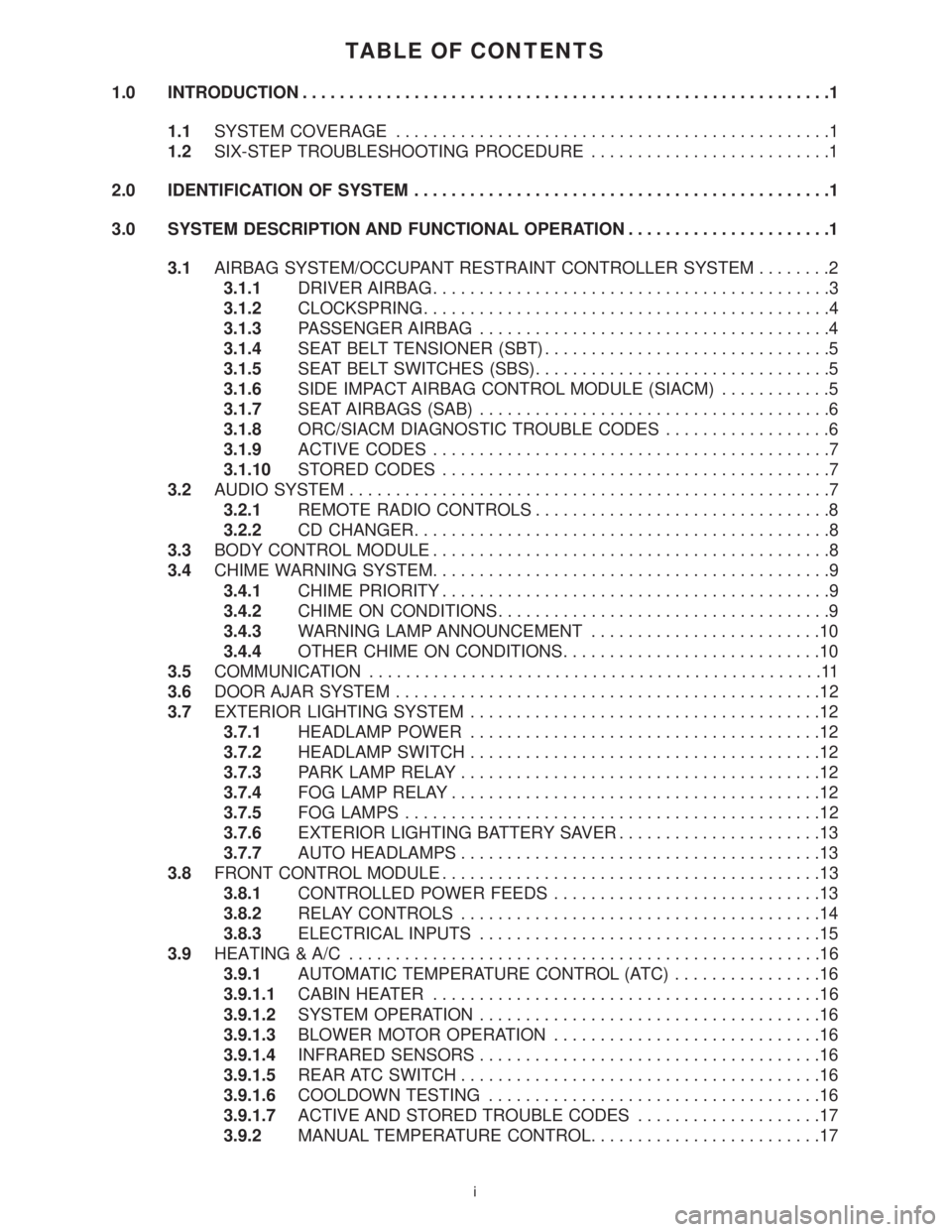
TABLE OF CONTENTS
1.0 INTRODUCTION.........................................................1
1.1SYSTEM COVERAGE...............................................1
1.2SIX-STEP TROUBLESHOOTING PROCEDURE..........................1
2.0 IDENTIFICATION OF SYSTEM.............................................1
3.0 SYSTEM DESCRIPTION AND FUNCTIONAL OPERATION......................1
3.1AIRBAG SYSTEM/OCCUPANT RESTRAINT CONTROLLER SYSTEM........2
3.1.1DRIVER AIRBAG...........................................3
3.1.2CLOCKSPRING............................................4
3.1.3PASSENGER AIRBAG......................................4
3.1.4SEAT BELT TENSIONER (SBT)...............................5
3.1.5SEAT BELT SWITCHES (SBS)................................5
3.1.6SIDE IMPACT AIRBAG CONTROL MODULE (SIACM)............5
3.1.7SEAT AIRBAGS (SAB)......................................6
3.1.8ORC/SIACM DIAGNOSTIC TROUBLE CODES..................6
3.1.9ACTIVE CODES...........................................7
3.1.10STORED CODES..........................................7
3.2AUDIO SYSTEM....................................................7
3.2.1REMOTE RADIO CONTROLS................................8
3.2.2CD CHANGER.............................................8
3.3BODY CONTROL MODULE...........................................8
3.4CHIME WARNING SYSTEM...........................................9
3.4.1CHIME PRIORITY..........................................9
3.4.2CHIME ON CONDITIONS....................................9
3.4.3WARNING LAMP ANNOUNCEMENT.........................10
3.4.4OTHER CHIME ON CONDITIONS............................10
3.5COMMUNICATION.................................................11
3.6DOOR AJAR SYSTEM..............................................12
3.7EXTERIOR LIGHTING SYSTEM......................................12
3.7.1HEADLAMP POWER......................................12
3.7.2HEADLAMP SWITCH......................................12
3.7.3PARK LAMP RELAY.......................................12
3.7.4FOG LAMP RELAY........................................12
3.7.5FOG LAMPS.............................................12
3.7.6EXTERIOR LIGHTING BATTERY SAVER......................13
3.7.7AUTO HEADLAMPS.......................................13
3.8FRONT CONTROL MODULE.........................................13
3.8.1CONTROLLED POWER FEEDS.............................13
3.8.2RELAY CONTROLS.......................................14
3.8.3ELECTRICAL INPUTS.....................................15
3.9HEATING & A/C...................................................16
3.9.1AUTOMATIC TEMPERATURE CONTROL (ATC)................16
3.9.1.1CABIN HEATER..........................................16
3.9.1.2SYSTEM OPERATION.....................................16
3.9.1.3BLOWER MOTOR OPERATION.............................16
3.9.1.4INFRARED SENSORS.....................................16
3.9.1.5REAR ATC SWITCH.......................................16
3.9.1.6COOLDOWN TESTING....................................16
3.9.1.7ACTIVE AND STORED TROUBLE CODES....................17
3.9.2MANUAL TEMPERATURE CONTROL.........................17
i
Page 6 of 4284
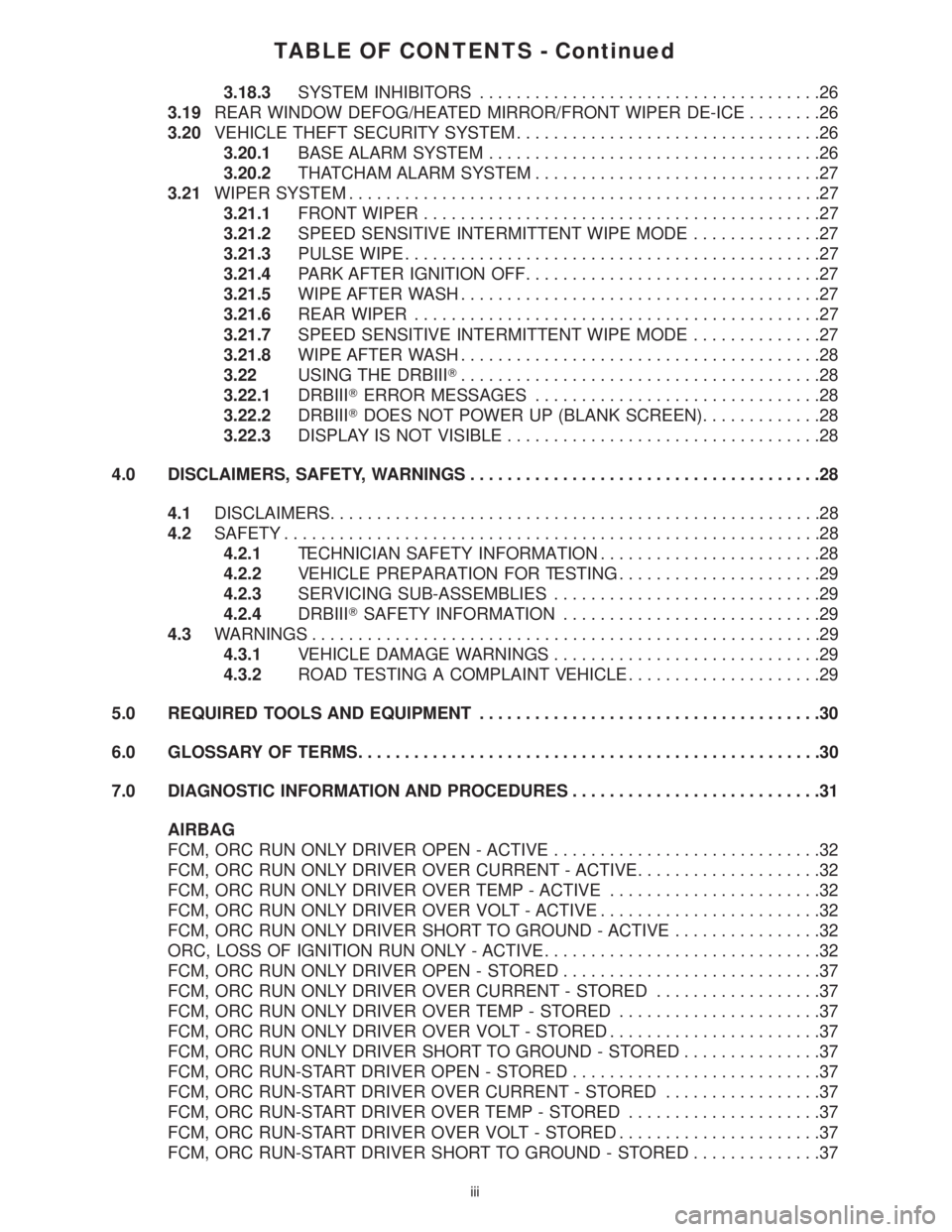
TABLE OF CONTENTS - Continued
3.18.3SYSTEM INHIBITORS.....................................26
3.19REAR WINDOW DEFOG/HEATED MIRROR/FRONT WIPER DE-ICE........26
3.20VEHICLE THEFT SECURITY SYSTEM.................................26
3.20.1BASE ALARM SYSTEM....................................26
3.20.2THATCHAM ALARM SYSTEM...............................27
3.21WIPER SYSTEM...................................................27
3.21.1FRONT WIPER...........................................27
3.21.2SPEED SENSITIVE INTERMITTENT WIPE MODE..............27
3.21.3PULSE WIPE.............................................27
3.21.4PARK AFTER IGNITION OFF................................27
3.21.5WIPE AFTER WASH.......................................27
3.21.6REAR WIPER............................................27
3.21.7SPEED SENSITIVE INTERMITTENT WIPE MODE..............27
3.21.8WIPE AFTER WASH.......................................28
3.22USING THE DRBIIIT.......................................28
3.22.1DRBIIITERROR MESSAGES...............................28
3.22.2DRBIIITDOES NOT POWER UP (BLANK SCREEN).............28
3.22.3DISPLAY IS NOT VISIBLE..................................28
4.0 DISCLAIMERS, SAFETY, WARNINGS......................................28
4.1DISCLAIMERS.....................................................28
4.2SAFETY..........................................................28
4.2.1TECHNICIAN SAFETY INFORMATION........................28
4.2.2VEHICLE PREPARATION FOR TESTING......................29
4.2.3SERVICING SUB-ASSEMBLIES.............................29
4.2.4DRBIIITSAFETY INFORMATION............................29
4.3WARNINGS.......................................................29
4.3.1VEHICLE DAMAGE WARNINGS.............................29
4.3.2ROAD TESTING A COMPLAINT VEHICLE.....................29
5.0 REQUIRED TOOLS AND EQUIPMENT.....................................30
6.0 GLOSSARY OF TERMS..................................................30
7.0 DIAGNOSTIC INFORMATION AND PROCEDURES...........................31
AIRBAG
FCM, ORC RUN ONLY DRIVER OPEN - ACTIVE.............................32
FCM, ORC RUN ONLY DRIVER OVER CURRENT - ACTIVE....................32
FCM, ORC RUN ONLY DRIVER OVER TEMP - ACTIVE.......................32
FCM, ORC RUN ONLY DRIVER OVER VOLT - ACTIVE........................32
FCM, ORC RUN ONLY DRIVER SHORT TO GROUND - ACTIVE................32
ORC, LOSS OF IGNITION RUN ONLY - ACTIVE..............................32
FCM, ORC RUN ONLY DRIVER OPEN - STORED............................37
FCM, ORC RUN ONLY DRIVER OVER CURRENT - STORED..................37
FCM, ORC RUN ONLY DRIVER OVER TEMP - STORED......................37
FCM, ORC RUN ONLY DRIVER OVER VOLT - STORED.......................37
FCM, ORC RUN ONLY DRIVER SHORT TO GROUND - STORED...............37
FCM, ORC RUN-START DRIVER OPEN - STORED...........................37
FCM, ORC RUN-START DRIVER OVER CURRENT - STORED.................37
FCM, ORC RUN-START DRIVER OVER TEMP - STORED.....................37
FCM, ORC RUN-START DRIVER OVER VOLT - STORED......................37
FCM, ORC RUN-START DRIVER SHORT TO GROUND - STORED..............37
iii
Page 8 of 4284
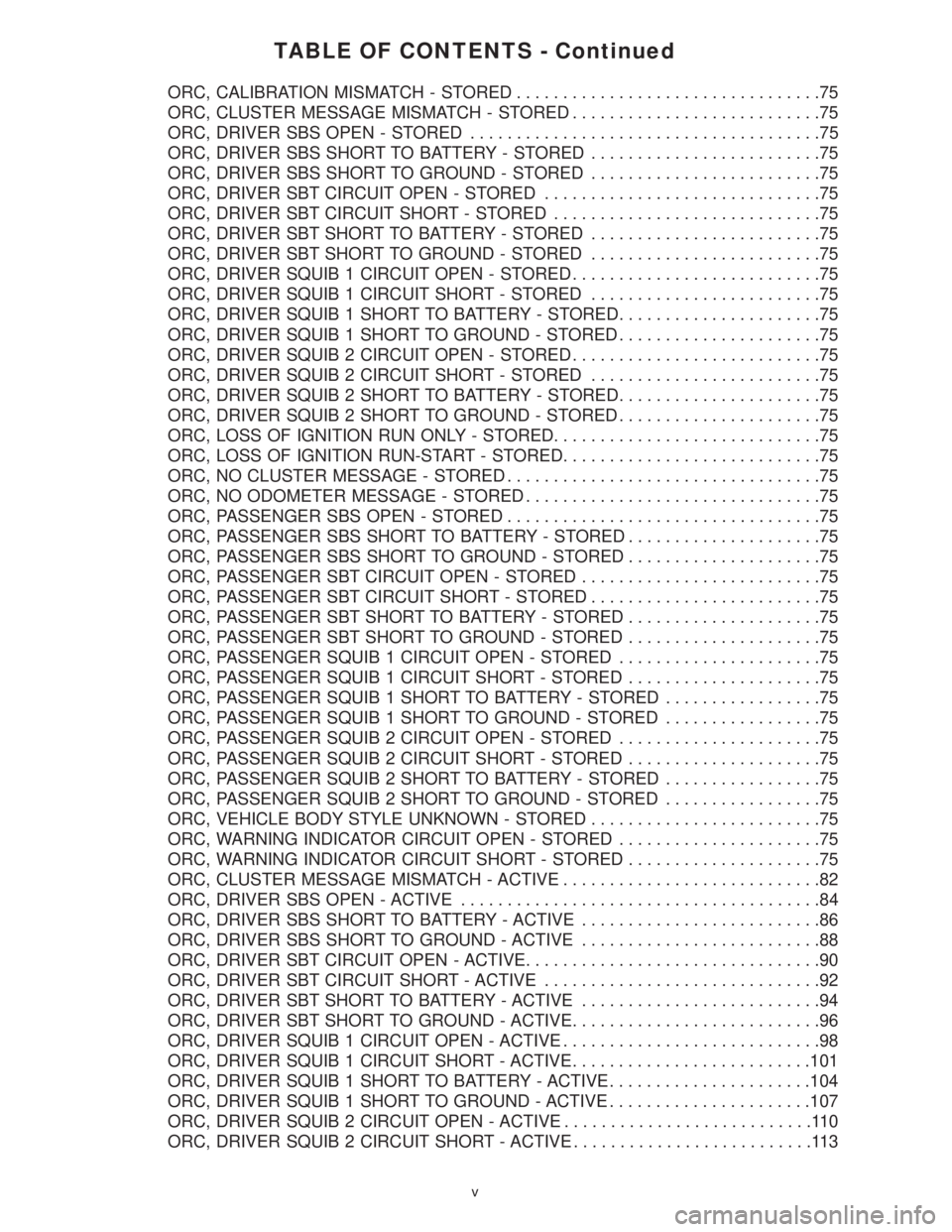
TABLE OF CONTENTS - Continued
ORC, CALIBRATION MISMATCH - STORED.................................75
ORC, CLUSTER MESSAGE MISMATCH - STORED...........................75
ORC, DRIVER SBS OPEN - STORED......................................75
ORC, DRIVER SBS SHORT TO BATTERY - STORED.........................75
ORC, DRIVER SBS SHORT TO GROUND - STORED.........................75
ORC, DRIVER SBT CIRCUIT OPEN - STORED..............................75
ORC, DRIVER SBT CIRCUIT SHORT - STORED.............................75
ORC, DRIVER SBT SHORT TO BATTERY - STORED.........................75
ORC, DRIVER SBT SHORT TO GROUND - STORED.........................75
ORC, DRIVER SQUIB 1 CIRCUIT OPEN - STORED...........................75
ORC, DRIVER SQUIB 1 CIRCUIT SHORT - STORED.........................75
ORC, DRIVER SQUIB 1 SHORT TO BATTERY - STORED......................75
ORC, DRIVER SQUIB 1 SHORT TO GROUND - STORED......................75
ORC, DRIVER SQUIB 2 CIRCUIT OPEN - STORED...........................75
ORC, DRIVER SQUIB 2 CIRCUIT SHORT - STORED.........................75
ORC, DRIVER SQUIB 2 SHORT TO BATTERY - STORED......................75
ORC, DRIVER SQUIB 2 SHORT TO GROUND - STORED......................75
ORC, LOSS OF IGNITION RUN ONLY - STORED.............................75
ORC, LOSS OF IGNITION RUN-START - STORED............................75
ORC, NO CLUSTER MESSAGE - STORED..................................75
ORC, NO ODOMETER MESSAGE - STORED................................75
ORC, PASSENGER SBS OPEN - STORED..................................75
ORC, PASSENGER SBS SHORT TO BATTERY - STORED.....................75
ORC, PASSENGER SBS SHORT TO GROUND - STORED.....................75
ORC, PASSENGER SBT CIRCUIT OPEN - STORED..........................75
ORC, PASSENGER SBT CIRCUIT SHORT - STORED.........................75
ORC, PASSENGER SBT SHORT TO BATTERY - STORED.....................75
ORC, PASSENGER SBT SHORT TO GROUND - STORED.....................75
ORC, PASSENGER SQUIB 1 CIRCUIT OPEN - STORED......................75
ORC, PASSENGER SQUIB 1 CIRCUIT SHORT - STORED.....................75
ORC, PASSENGER SQUIB 1 SHORT TO BATTERY - STORED.................75
ORC, PASSENGER SQUIB 1 SHORT TO GROUND - STORED.................75
ORC, PASSENGER SQUIB 2 CIRCUIT OPEN - STORED......................75
ORC, PASSENGER SQUIB 2 CIRCUIT SHORT - STORED.....................75
ORC, PASSENGER SQUIB 2 SHORT TO BATTERY - STORED.................75
ORC, PASSENGER SQUIB 2 SHORT TO GROUND - STORED.................75
ORC, VEHICLE BODY STYLE UNKNOWN - STORED.........................75
ORC, WARNING INDICATOR CIRCUIT OPEN - STORED......................75
ORC, WARNING INDICATOR CIRCUIT SHORT - STORED.....................75
ORC, CLUSTER MESSAGE MISMATCH - ACTIVE............................82
ORC, DRIVER SBS OPEN - ACTIVE.......................................84
ORC, DRIVER SBS SHORT TO BATTERY - ACTIVE..........................86
ORC, DRIVER SBS SHORT TO GROUND - ACTIVE..........................88
ORC, DRIVER SBT CIRCUIT OPEN - ACTIVE................................90
ORC, DRIVER SBT CIRCUIT SHORT - ACTIVE..............................92
ORC, DRIVER SBT SHORT TO BATTERY - ACTIVE..........................94
ORC, DRIVER SBT SHORT TO GROUND - ACTIVE...........................96
ORC, DRIVER SQUIB 1 CIRCUIT OPEN - ACTIVE............................98
ORC, DRIVER SQUIB 1 CIRCUIT SHORT - ACTIVE..........................101
ORC, DRIVER SQUIB 1 SHORT TO BATTERY - ACTIVE......................104
ORC, DRIVER SQUIB 1 SHORT TO GROUND - ACTIVE......................107
ORC, DRIVER SQUIB 2 CIRCUIT OPEN - ACTIVE...........................110
ORC, DRIVER SQUIB 2 CIRCUIT SHORT - ACTIVE..........................113
v
Page 9 of 4284
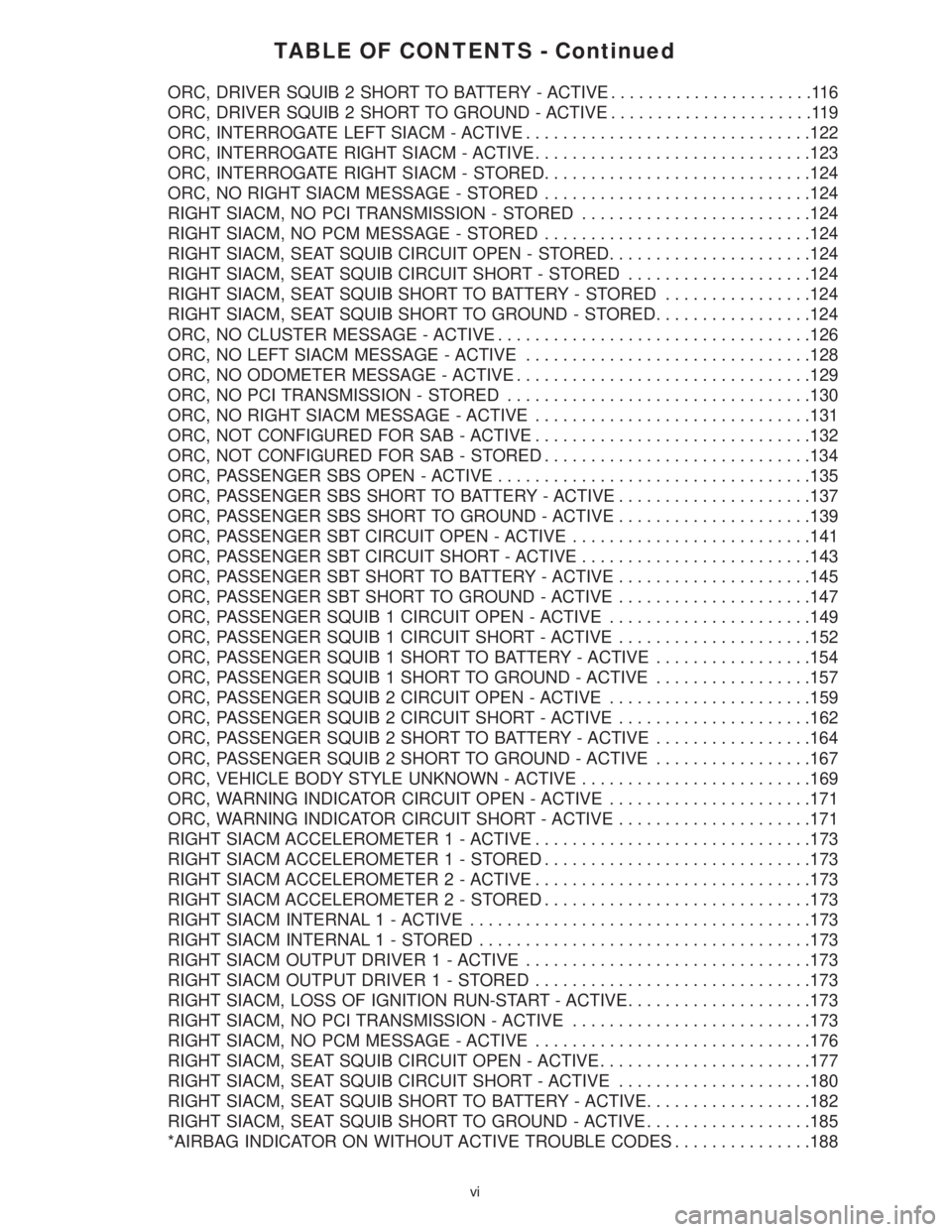
TABLE OF CONTENTS - Continued
ORC, DRIVER SQUIB 2 SHORT TO BATTERY - ACTIVE......................116
ORC, DRIVER SQUIB 2 SHORT TO GROUND - ACTIVE......................119
ORC, INTERROGATE LEFT SIACM - ACTIVE...............................122
ORC, INTERROGATE RIGHT SIACM - ACTIVE..............................123
ORC, INTERROGATE RIGHT SIACM - STORED.............................124
ORC, NO RIGHT SIACM MESSAGE - STORED.............................124
RIGHT SIACM, NO PCI TRANSMISSION - STORED.........................124
RIGHT SIACM, NO PCM MESSAGE - STORED.............................124
RIGHT SIACM, SEAT SQUIB CIRCUIT OPEN - STORED......................124
RIGHT SIACM, SEAT SQUIB CIRCUIT SHORT - STORED....................124
RIGHT SIACM, SEAT SQUIB SHORT TO BATTERY - STORED................124
RIGHT SIACM, SEAT SQUIB SHORT TO GROUND - STORED.................124
ORC, NO CLUSTER MESSAGE - ACTIVE..................................126
ORC, NO LEFT SIACM MESSAGE - ACTIVE...............................128
ORC, NO ODOMETER MESSAGE - ACTIVE................................129
ORC, NO PCI TRANSMISSION - STORED.................................130
ORC, NO RIGHT SIACM MESSAGE - ACTIVE..............................131
ORC, NOT CONFIGURED FOR SAB - ACTIVE..............................132
ORC, NOT CONFIGURED FOR SAB - STORED.............................134
ORC, PASSENGER SBS OPEN - ACTIVE..................................135
ORC, PASSENGER SBS SHORT TO BATTERY - ACTIVE.....................137
ORC, PASSENGER SBS SHORT TO GROUND - ACTIVE.....................139
ORC, PASSENGER SBT CIRCUIT OPEN - ACTIVE..........................141
ORC, PASSENGER SBT CIRCUIT SHORT - ACTIVE.........................143
ORC, PASSENGER SBT SHORT TO BATTERY - ACTIVE.....................145
ORC, PASSENGER SBT SHORT TO GROUND - ACTIVE.....................147
ORC, PASSENGER SQUIB 1 CIRCUIT OPEN - ACTIVE......................149
ORC, PASSENGER SQUIB 1 CIRCUIT SHORT - ACTIVE.....................152
ORC, PASSENGER SQUIB 1 SHORT TO BATTERY - ACTIVE.................154
ORC, PASSENGER SQUIB 1 SHORT TO GROUND - ACTIVE.................157
ORC, PASSENGER SQUIB 2 CIRCUIT OPEN - ACTIVE......................159
ORC, PASSENGER SQUIB 2 CIRCUIT SHORT - ACTIVE.....................162
ORC, PASSENGER SQUIB 2 SHORT TO BATTERY - ACTIVE.................164
ORC, PASSENGER SQUIB 2 SHORT TO GROUND - ACTIVE.................167
ORC, VEHICLE BODY STYLE UNKNOWN - ACTIVE.........................169
ORC, WARNING INDICATOR CIRCUIT OPEN - ACTIVE......................171
ORC, WARNING INDICATOR CIRCUIT SHORT - ACTIVE.....................171
RIGHT SIACM ACCELEROMETER 1 - ACTIVE..............................173
RIGHT SIACM ACCELEROMETER1-STORED.............................173
RIGHT SIACM ACCELEROMETER 2 - ACTIVE..............................173
RIGHT SIACM ACCELEROMETER2-STORED.............................173
RIGHT SIACM INTERNAL 1 - ACTIVE.....................................173
RIGHT SIACM INTERNAL 1 - STORED....................................173
RIGHT SIACM OUTPUT DRIVER 1 - ACTIVE...............................173
RIGHT SIACM OUTPUT DRIVER1-STORED..............................173
RIGHT SIACM, LOSS OF IGNITION RUN-START - ACTIVE....................173
RIGHT SIACM, NO PCI TRANSMISSION - ACTIVE..........................173
RIGHT SIACM, NO PCM MESSAGE - ACTIVE..............................176
RIGHT SIACM, SEAT SQUIB CIRCUIT OPEN - ACTIVE.......................177
RIGHT SIACM, SEAT SQUIB CIRCUIT SHORT - ACTIVE.....................180
RIGHT SIACM, SEAT SQUIB SHORT TO BATTERY - ACTIVE..................182
RIGHT SIACM, SEAT SQUIB SHORT TO GROUND - ACTIVE..................185
*AIRBAG INDICATOR ON WITHOUT ACTIVE TROUBLE CODES...............188
vi
Page 13 of 4284
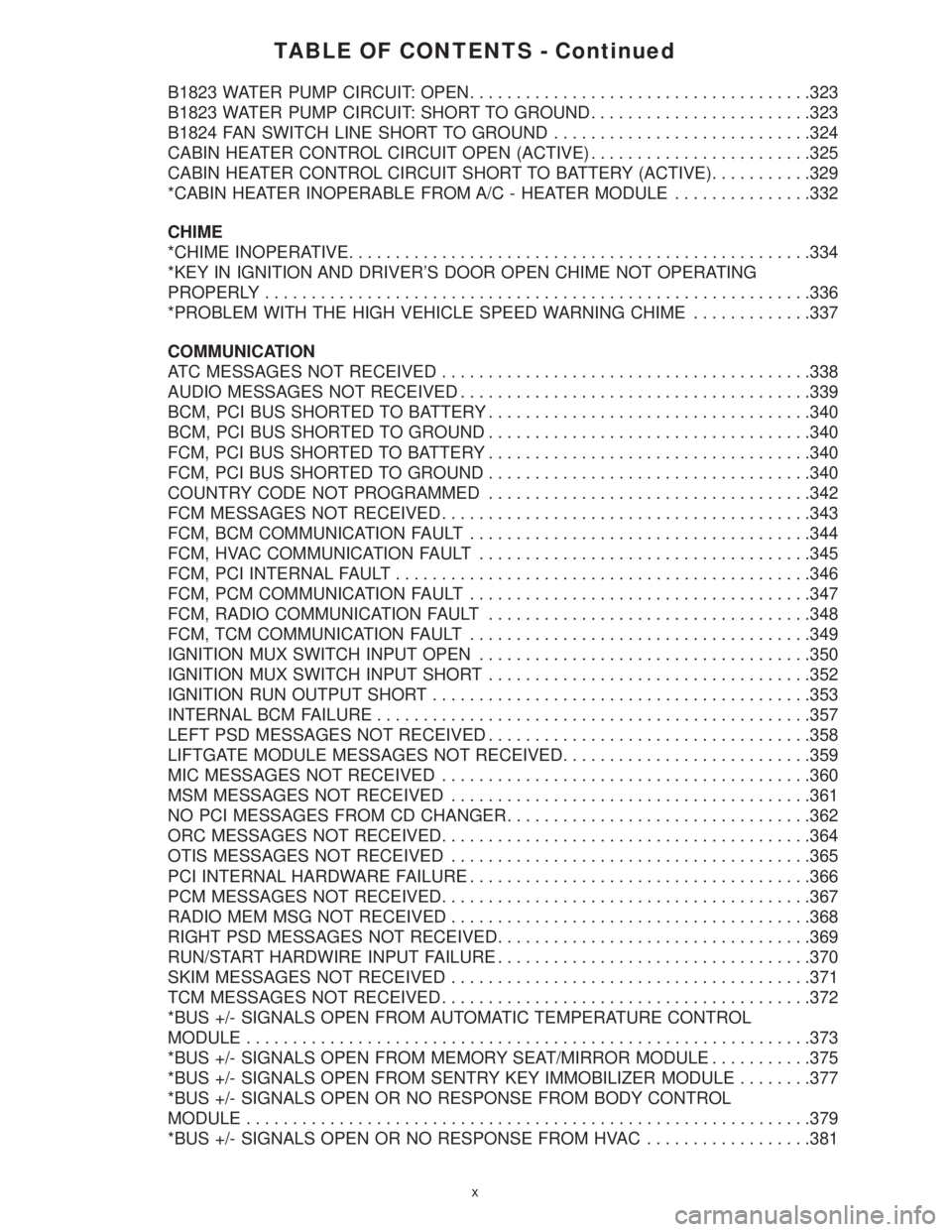
TABLE OF CONTENTS - Continued
B1823 WATER PUMP CIRCUIT: OPEN.....................................323
B1823 WATER PUMP CIRCUIT: SHORT TO GROUND........................323
B1824 FAN SWITCH LINE SHORT TO GROUND............................324
CABIN HEATER CONTROL CIRCUIT OPEN (ACTIVE)........................325
CABIN HEATER CONTROL CIRCUIT SHORT TO BATTERY (ACTIVE)...........329
*CABIN HEATER INOPERABLE FROM A/C - HEATER MODULE...............332
CHIME
*CHIME INOPERATIVE..................................................334
*KEY IN IGNITION AND DRIVER'S DOOR OPEN CHIME NOT OPERATING
PROPERLY...........................................................336
*PROBLEM WITH THE HIGH VEHICLE SPEED WARNING CHIME.............337
COMMUNICATION
ATC MESSAGES NOT RECEIVED........................................338
AUDIO MESSAGES NOT RECEIVED......................................339
BCM, PCI BUS SHORTED TO BATTERY...................................340
BCM, PCI BUS SHORTED TO GROUND...................................340
FCM, PCI BUS SHORTED TO BATTERY...................................340
FCM, PCI BUS SHORTED TO GROUND...................................340
COUNTRY CODE NOT PROGRAMMED...................................342
FCM MESSAGES NOT RECEIVED........................................343
FCM, BCM COMMUNICATION FAULT.....................................344
FCM, HVAC COMMUNICATION FAULT....................................345
FCM, PCI INTERNAL FAULT.............................................346
FCM, PCM COMMUNICATION FAULT.....................................347
FCM, RADIO COMMUNICATION FAULT...................................348
FCM, TCM COMMUNICATION FAULT.....................................349
IGNITION MUX SWITCH INPUT OPEN....................................350
IGNITION MUX SWITCH INPUT SHORT...................................352
IGNITION RUN OUTPUT SHORT.........................................353
INTERNAL BCM FAILURE...............................................357
LEFT PSD MESSAGES NOT RECEIVED...................................358
LIFTGATE MODULE MESSAGES NOT RECEIVED...........................359
MIC MESSAGES NOT RECEIVED........................................360
MSM MESSAGES NOT RECEIVED.......................................361
NO PCI MESSAGES FROM CD CHANGER.................................362
ORC MESSAGES NOT RECEIVED........................................364
OTIS MESSAGES NOT RECEIVED.......................................365
PCI INTERNAL HARDWARE FAILURE.....................................366
PCM MESSAGES NOT RECEIVED........................................367
RADIO MEM MSG NOT RECEIVED.......................................368
RIGHT PSD MESSAGES NOT RECEIVED..................................369
RUN/START HARDWIRE INPUT FAILURE..................................370
SKIM MESSAGES NOT RECEIVED.......................................371
TCM MESSAGES NOT RECEIVED........................................372
*BUS +/- SIGNALS OPEN FROM AUTOMATIC TEMPERATURE CONTROL
MODULE.............................................................373
*BUS +/- SIGNALS OPEN FROM MEMORY SEAT/MIRROR MODULE...........375
*BUS +/- SIGNALS OPEN FROM SENTRY KEY IMMOBILIZER MODULE........377
*BUS +/- SIGNALS OPEN OR NO RESPONSE FROM BODY CONTROL
MODULE.............................................................379
*BUS +/- SIGNALS OPEN OR NO RESPONSE FROM HVAC..................381
x
Page 31 of 4284
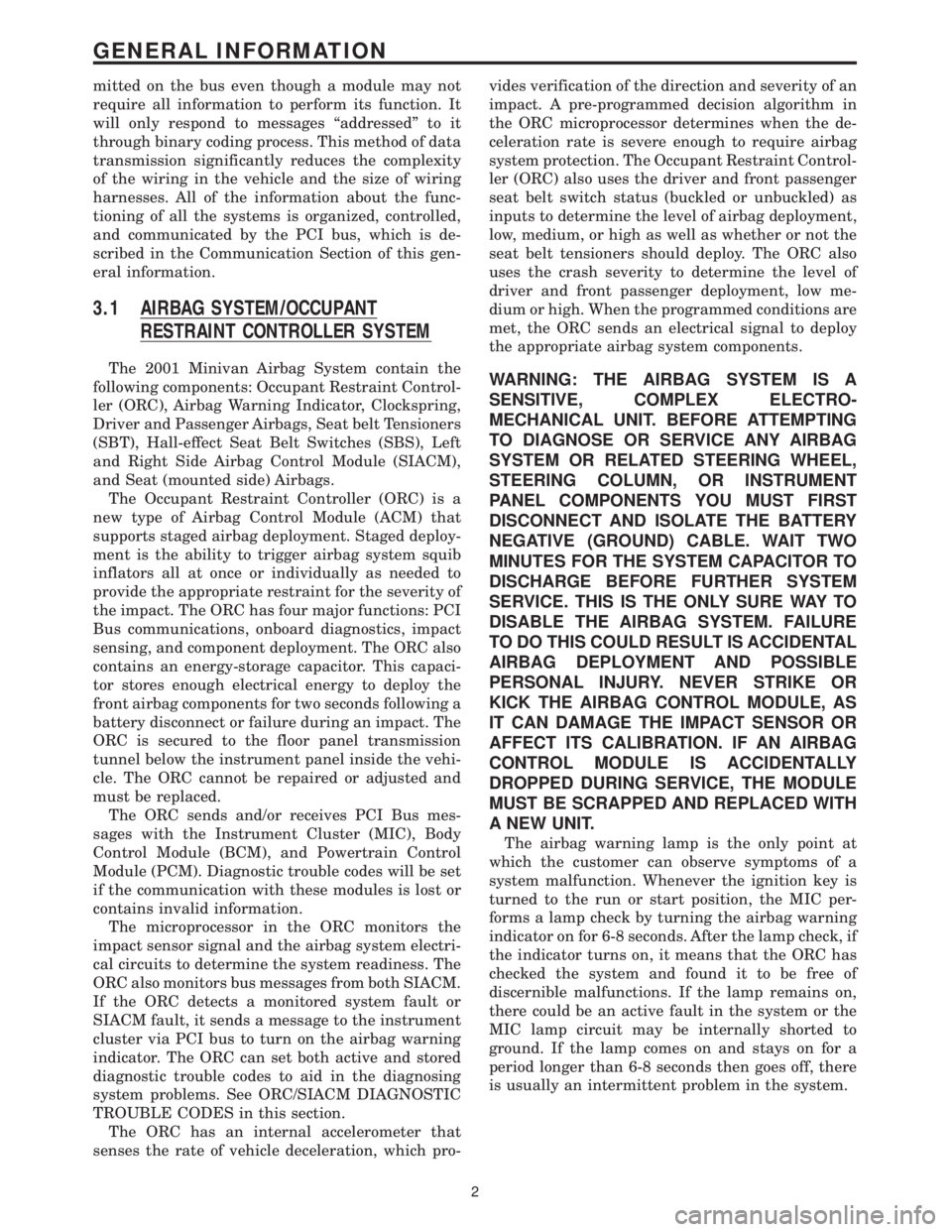
mitted on the bus even though a module may not
require all information to perform its function. It
will only respond to messages ªaddressedº to it
through binary coding process. This method of data
transmission significantly reduces the complexity
of the wiring in the vehicle and the size of wiring
harnesses. All of the information about the func-
tioning of all the systems is organized, controlled,
and communicated by the PCI bus, which is de-
scribed in the Communication Section of this gen-
eral information.
3.1 AIRBAG SYSTEM/OCCUPANT
RESTRAINT CONTROLLER SYSTEM
The 2001 Minivan Airbag System contain the
following components: Occupant Restraint Control-
ler (ORC), Airbag Warning Indicator, Clockspring,
Driver and Passenger Airbags, Seat belt Tensioners
(SBT), Hall-effect Seat Belt Switches (SBS), Left
and Right Side Airbag Control Module (SIACM),
and Seat (mounted side) Airbags.
The Occupant Restraint Controller (ORC) is a
new type of Airbag Control Module (ACM) that
supports staged airbag deployment. Staged deploy-
ment is the ability to trigger airbag system squib
inflators all at once or individually as needed to
provide the appropriate restraint for the severity of
the impact. The ORC has four major functions: PCI
Bus communications, onboard diagnostics, impact
sensing, and component deployment. The ORC also
contains an energy-storage capacitor. This capaci-
tor stores enough electrical energy to deploy the
front airbag components for two seconds following a
battery disconnect or failure during an impact. The
ORC is secured to the floor panel transmission
tunnel below the instrument panel inside the vehi-
cle. The ORC cannot be repaired or adjusted and
must be replaced.
The ORC sends and/or receives PCI Bus mes-
sages with the Instrument Cluster (MIC), Body
Control Module (BCM), and Powertrain Control
Module (PCM). Diagnostic trouble codes will be set
if the communication with these modules is lost or
contains invalid information.
The microprocessor in the ORC monitors the
impact sensor signal and the airbag system electri-
cal circuits to determine the system readiness. The
ORC also monitors bus messages from both SIACM.
If the ORC detects a monitored system fault or
SIACM fault, it sends a message to the instrument
cluster via PCI bus to turn on the airbag warning
indicator. The ORC can set both active and stored
diagnostic trouble codes to aid in the diagnosing
system problems. See ORC/SIACM DIAGNOSTIC
TROUBLE CODES in this section.
The ORC has an internal accelerometer that
senses the rate of vehicle deceleration, which pro-vides verification of the direction and severity of an
impact. A pre-programmed decision algorithm in
the ORC microprocessor determines when the de-
celeration rate is severe enough to require airbag
system protection. The Occupant Restraint Control-
ler (ORC) also uses the driver and front passenger
seat belt switch status (buckled or unbuckled) as
inputs to determine the level of airbag deployment,
low, medium, or high as well as whether or not the
seat belt tensioners should deploy. The ORC also
uses the crash severity to determine the level of
driver and front passenger deployment, low me-
dium or high. When the programmed conditions are
met, the ORC sends an electrical signal to deploy
the appropriate airbag system components.WARNING: THE AIRBAG SYSTEM IS A
SENSITIVE, COMPLEX ELECTRO-
MECHANICAL UNIT. BEFORE ATTEMPTING
TO DIAGNOSE OR SERVICE ANY AIRBAG
SYSTEM OR RELATED STEERING WHEEL,
STEERING COLUMN, OR INSTRUMENT
PANEL COMPONENTS YOU MUST FIRST
DISCONNECT AND ISOLATE THE BATTERY
NEGATIVE (GROUND) CABLE. WAIT TWO
MINUTES FOR THE SYSTEM CAPACITOR TO
DISCHARGE BEFORE FURTHER SYSTEM
SERVICE. THIS IS THE ONLY SURE WAY TO
DISABLE THE AIRBAG SYSTEM. FAILURE
TO DO THIS COULD RESULT IS ACCIDENTAL
AIRBAG DEPLOYMENT AND POSSIBLE
PERSONAL INJURY. NEVER STRIKE OR
KICK THE AIRBAG CONTROL MODULE, AS
IT CAN DAMAGE THE IMPACT SENSOR OR
AFFECT ITS CALIBRATION. IF AN AIRBAG
CONTROL MODULE IS ACCIDENTALLY
DROPPED DURING SERVICE, THE MODULE
MUST BE SCRAPPED AND REPLACED WITH
A NEW UNIT.
The airbag warning lamp is the only point at
which the customer can observe symptoms of a
system malfunction. Whenever the ignition key is
turned to the run or start position, the MIC per-
forms a lamp check by turning the airbag warning
indicator on for 6-8 seconds. After the lamp check, if
the indicator turns on, it means that the ORC has
checked the system and found it to be free of
discernible malfunctions. If the lamp remains on,
there could be an active fault in the system or the
MIC lamp circuit may be internally shorted to
ground. If the lamp comes on and stays on for a
period longer than 6-8 seconds then goes off, there
is usually an intermittent problem in the system.
2
GENERAL INFORMATION
Page 32 of 4284
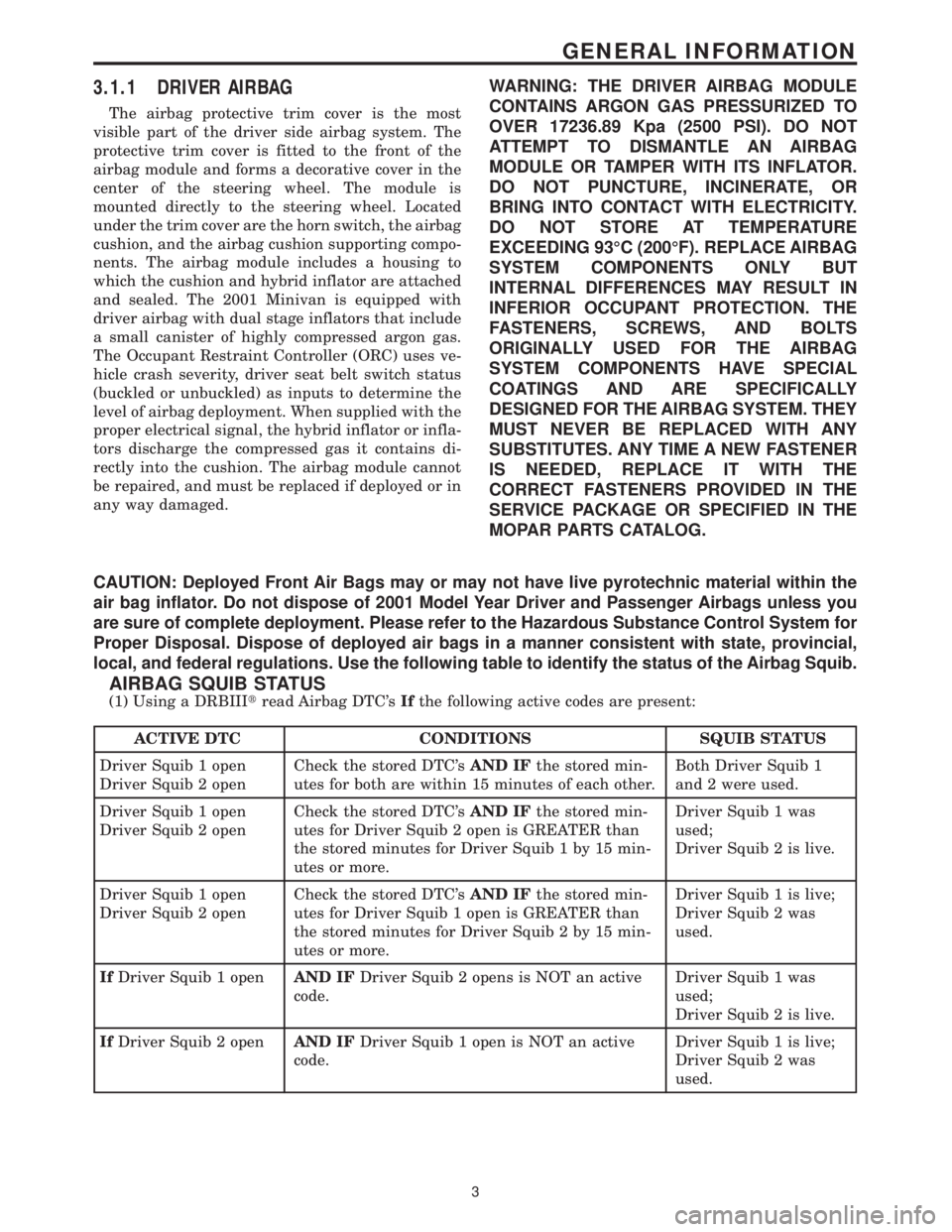
3.1.1 DRIVER AIRBAG
The airbag protective trim cover is the most
visible part of the driver side airbag system. The
protective trim cover is fitted to the front of the
airbag module and forms a decorative cover in the
center of the steering wheel. The module is
mounted directly to the steering wheel. Located
under the trim cover are the horn switch, the airbag
cushion, and the airbag cushion supporting compo-
nents. The airbag module includes a housing to
which the cushion and hybrid inflator are attached
and sealed. The 2001 Minivan is equipped with
driver airbag with dual stage inflators that include
a small canister of highly compressed argon gas.
The Occupant Restraint Controller (ORC) uses ve-
hicle crash severity, driver seat belt switch status
(buckled or unbuckled) as inputs to determine the
level of airbag deployment. When supplied with the
proper electrical signal, the hybrid inflator or infla-
tors discharge the compressed gas it contains di-
rectly into the cushion. The airbag module cannot
be repaired, and must be replaced if deployed or in
any way damaged.
WARNING: THE DRIVER AIRBAG MODULE
CONTAINS ARGON GAS PRESSURIZED TO
OVER 17236.89 Kpa (2500 PSI). DO NOT
ATTEMPT TO DISMANTLE AN AIRBAG
MODULE OR TAMPER WITH ITS INFLATOR.
DO NOT PUNCTURE, INCINERATE, OR
BRING INTO CONTACT WITH ELECTRICITY.
DO NOT STORE AT TEMPERATURE
EXCEEDING 93ÉC (200ÉF). REPLACE AIRBAG
SYSTEM COMPONENTS ONLY BUT
INTERNAL DIFFERENCES MAY RESULT IN
INFERIOR OCCUPANT PROTECTION. THE
FASTENERS, SCREWS, AND BOLTS
ORIGINALLY USED FOR THE AIRBAG
SYSTEM COMPONENTS HAVE SPECIAL
COATINGS AND ARE SPECIFICALLY
DESIGNED FOR THE AIRBAG SYSTEM. THEY
MUST NEVER BE REPLACED WITH ANY
SUBSTITUTES. ANY TIME A NEW FASTENER
IS NEEDED, REPLACE IT WITH THE
CORRECT FASTENERS PROVIDED IN THE
SERVICE PACKAGE OR SPECIFIED IN THE
MOPAR PARTS CATALOG.
CAUTION: Deployed Front Air Bags may or may not have live pyrotechnic material within the
air bag inflator. Do not dispose of 2001 Model Year Driver and Passenger Airbags unless you
are sure of complete deployment. Please refer to the Hazardous Substance Control System for
Proper Disposal. Dispose of deployed air bags in a manner consistent with state, provincial,
local, and federal regulations. Use the following table to identify the status of the Airbag Squib.
AIRBAG SQUIB STATUS
(1) Using a DRBIIItread Airbag DTC'sIfthe following active codes are present:
ACTIVE DTC CONDITIONS SQUIB STATUS
Driver Squib 1 open
Driver Squib 2 openCheck the stored DTC'sAND IFthe stored min-
utes for both are within 15 minutes of each other.Both Driver Squib 1
and 2 were used.
Driver Squib 1 open
Driver Squib 2 openCheck the stored DTC'sAND IFthe stored min-
utes for Driver Squib 2 open is GREATER than
the stored minutes for Driver Squib 1 by 15 min-
utes or more.Driver Squib 1 was
used;
Driver Squib 2 is live.
Driver Squib 1 open
Driver Squib 2 openCheck the stored DTC'sAND IFthe stored min-
utes for Driver Squib 1 open is GREATER than
the stored minutes for Driver Squib 2 by 15 min-
utes or more.Driver Squib 1 is live;
Driver Squib 2 was
used.
IfDriver Squib 1 openAND IFDriver Squib 2 opens is NOT an active
code.Driver Squib 1 was
used;
Driver Squib 2 is live.
IfDriver Squib 2 openAND IFDriver Squib 1 open is NOT an active
code.Driver Squib 1 is live;
Driver Squib 2 was
used.
3
GENERAL INFORMATION
Page 33 of 4284
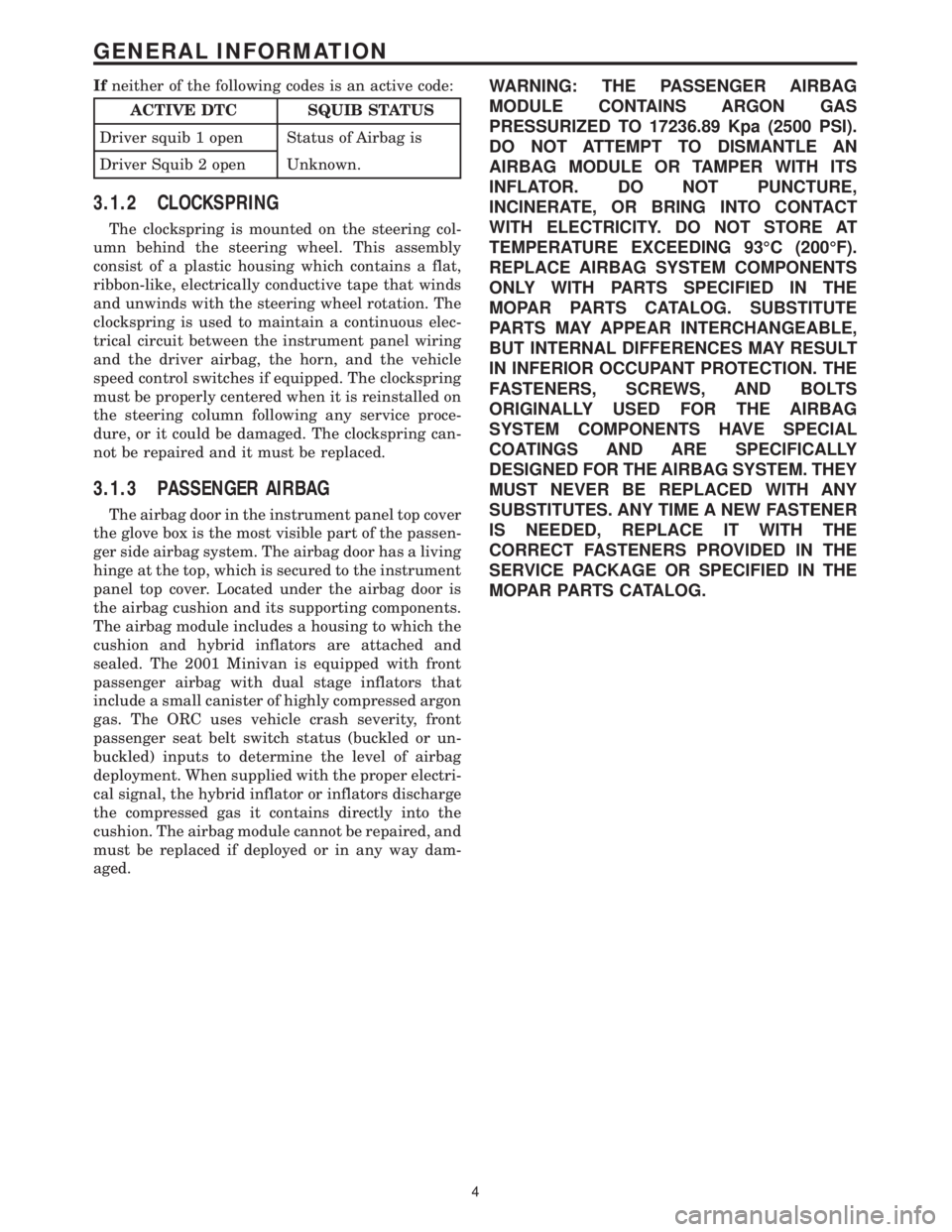
Ifneither of the following codes is an active code:
ACTIVE DTC SQUIB STATUS
Driver squib 1 open Status of Airbag is
Driver Squib 2 open Unknown.
3.1.2 CLOCKSPRING
The clockspring is mounted on the steering col-
umn behind the steering wheel. This assembly
consist of a plastic housing which contains a flat,
ribbon-like, electrically conductive tape that winds
and unwinds with the steering wheel rotation. The
clockspring is used to maintain a continuous elec-
trical circuit between the instrument panel wiring
and the driver airbag, the horn, and the vehicle
speed control switches if equipped. The clockspring
must be properly centered when it is reinstalled on
the steering column following any service proce-
dure, or it could be damaged. The clockspring can-
not be repaired and it must be replaced.
3.1.3 PASSENGER AIRBAG
The airbag door in the instrument panel top cover
the glove box is the most visible part of the passen-
ger side airbag system. The airbag door has a living
hinge at the top, which is secured to the instrument
panel top cover. Located under the airbag door is
the airbag cushion and its supporting components.
The airbag module includes a housing to which the
cushion and hybrid inflators are attached and
sealed. The 2001 Minivan is equipped with front
passenger airbag with dual stage inflators that
include a small canister of highly compressed argon
gas. The ORC uses vehicle crash severity, front
passenger seat belt switch status (buckled or un-
buckled) inputs to determine the level of airbag
deployment. When supplied with the proper electri-
cal signal, the hybrid inflator or inflators discharge
the compressed gas it contains directly into the
cushion. The airbag module cannot be repaired, and
must be replaced if deployed or in any way dam-
aged.
WARNING: THE PASSENGER AIRBAG
MODULE CONTAINS ARGON GAS
PRESSURIZED TO 17236.89 Kpa (2500 PSI).
DO NOT ATTEMPT TO DISMANTLE AN
AIRBAG MODULE OR TAMPER WITH ITS
INFLATOR. DO NOT PUNCTURE,
INCINERATE, OR BRING INTO CONTACT
WITH ELECTRICITY. DO NOT STORE AT
TEMPERATURE EXCEEDING 93ÉC (200ÉF).
REPLACE AIRBAG SYSTEM COMPONENTS
ONLY WITH PARTS SPECIFIED IN THE
MOPAR PARTS CATALOG. SUBSTITUTE
PARTS MAY APPEAR INTERCHANGEABLE,
BUT INTERNAL DIFFERENCES MAY RESULT
IN INFERIOR OCCUPANT PROTECTION. THE
FASTENERS, SCREWS, AND BOLTS
ORIGINALLY USED FOR THE AIRBAG
SYSTEM COMPONENTS HAVE SPECIAL
COATINGS AND ARE SPECIFICALLY
DESIGNED FOR THE AIRBAG SYSTEM. THEY
MUST NEVER BE REPLACED WITH ANY
SUBSTITUTES. ANY TIME A NEW FASTENER
IS NEEDED, REPLACE IT WITH THE
CORRECT FASTENERS PROVIDED IN THE
SERVICE PACKAGE OR SPECIFIED IN THE
MOPAR PARTS CATALOG.
4
GENERAL INFORMATION